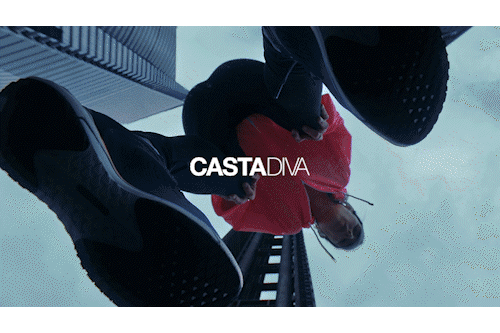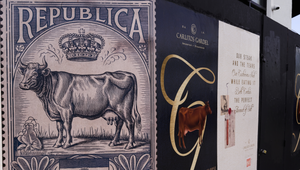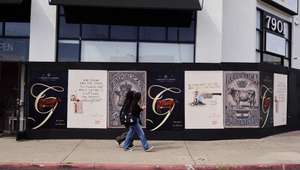
New Talent: Yisha Zhang

When Yisha Zhang first discovered that she could legitimately ‘do’ her favourite hobby of “creating whimsical things” as a job, there was only career path she was ever going to take. This isn’t one of those ‘I just fell into it’ scenarios but one of intent; for she made her discovery of the ‘whimsical thing creating’ industry, a.k.a. advertising, at the age of 14 during junior high in Shanghai, China. She now lives and works in Los Angeles as a Strategic Planner at Team One. Addison Capper chats with Zhang about how hipsters and geeks are the key to strategic planning and how Frank Sinatra and front-row bench car seats are pivotal pieces of knowledge when studying American culture.
LBB> You were born and raised in Shanghai, but now live in Los Angeles - when did you make the move and what was it about the U.S. that attracted you?
YZ> I moved to L.A. to attend grad school at USC. (Fight on, Trojans!) Now, more than four years later, I can no longer consider myself ‘fresh off the boat’. My dad is a very open-minded Asian parent. He suggested that no matter what I chose to do with the rest of my life, I should first explore and learn things in some other parts of the world. He then kicked me, the only child, out of the country and across the Pacific to North America. The higher education here in the U.S. was what truly attracted me.
LBB> Creatively, how do Shanghai and Los Angeles differ?
YZ> I always describe Shanghai as the oriental NYC. Both Shanghai and L.A. are big cities with great diversity – a key factor to creativity. However, Shanghai is more of a fast-moving metropolis with huge international business opportunities like Tokyo, Hong Kong and, of course, NYC. Los Angeles on the other hand, has this laid-back Golden State spirit. I’d probably work longer hours under greater pressure while making more money in Shanghai, but I feel happier ‘faking’ a California girl here. And a happy city boosts creativity.
LBB> What did you do prior to moving to the U.S. and how did you end up in the world of advertising?
YZ> Before moving to the States, I spent my entire life enjoying my childhood and ‘enjoying’ schooling. As a kid, I always had this wild imagination and was able to come up with whimsical things. The day I learned there’s such an industry that legitimately created whimsical ideas was the day I decided to go into advertising, probably when I was in junior high. (Yes, I was one of those strange kids who already knew what they would do for a living at the age of 14.) I studied advertising during my undergrad years, interned at a couple of agencies in Shanghai, tried out different positions, and figured that strategic planning was the right route to take. This was sorted out before grad school, and I’m still right on track today.
LBB> What benefits do you feel your global perspective brings to your role as a strategic planner at Team One?
YZ> My global perspective – the Asian upbringings combined with American learnings – enables me to look at problems from a unique angle, which in turn leads to unique insights. Insights are to a strategist what a sharp sword is to a warrior. In this sense, a global perspective provides me the skill to constantly wield sharp swords, allows me to fight through battles, and keeps me alive. Strange metaphors might be a by-product of this global perspective, too.
As Team One is a part of the global Saatchi & Saatchi network, and has several international brands on the client roster, including Lexus, The Ritz-Carlton and Häagen Dazs, I’m always the go-to Asian expert when it comes to Chinese language, cultural differences and communication norms. I also try my best to help my curious co-workers understand the mysterious and rapidly rising Chinese market.
LBB> And do you think that being a Chinese national working as a strategist in the U.S. brings any limitations?
YZ> In addition to the big disadvantage in the hiring process, which luckily Team One sees as a valuable investment, there are definitely language and cultural barriers. I’m still improving my English everyday, with the help of my lovely and very straightforward co-workers. I’m also learning everything that happened in the U.S. before I was born and everything that’s influenced the culture: from Frank Sinatra’s music to a vintage car’s front-row bench seat.
LBB> Having a role in strategy must involve a lot of research to stay afoot of new trends and technology - what do you do to ensure that you're always clued up?
YZ> I go window shopping, people watching and art-watching almost every weekend. Always keeping up with trends isn’t easy, but a strategist watches and learns from the people and world around them every single minute. Keep reading, exploring and absorbing. The best strategists work away from their desks.
People are my focus, technology isn’t. So I make friends with creative technologists, or innovationists, or whatever your agency calls the role – those who stay at the forefront of technology in agencies. Chat with them, follow them on Twitter and read what they tweet. Then I probably know 80 per cent of what they know.
Be a hipster and team up with geeks. That’s my strategy.
LBB> Which pieces of work that you've been involved in are you most proud of and why?
YZ> The 2013 ES Launch Campaign: I took an important strategy role in this high-profile national campaign early in my career. It involved a lot of late nights and a lot of learning while doing. I remember confidently giving strategic advices in large meetings but actually being nervous like the painting The Scream by Munch. It turned out to be insightful strategy and a strong campaign with great results. I grew much faster than I thought I would.
The 2013 CT Sustaining Campaign: In the same way that I was new to the strategy team at Team One, the CT was a fun, youthful and fairly new model to the Lexus line-up, targeted at young people. I saw a lot of things in common between me, the CT and the CT audience. Such connection sparked inspiration. The strategy led to a campaign that kicked off a new direction of Lexus advertising and the CT has been my favourite model to work on to this day.
The Legacy Project: This is a cultural study about how people and brands leave their marks in this world. My fellow strategists and I have been working on it for more than a year. It has given me the opportunity to talk to a variety of people from famous race car drivers to museum curators, from a homeless Swedish coder who lives and codes in the forest to a British app developer who lives on a boat in the canals in London. I have been amazed by how interesting the world can be and how much a strategist could learn simply through talking to interesting people.
LBB> Where do you see yourself in 10 years' time?
YZ> A planning director and a mom. The only thing that could ever beat my passion for creating whimsical ideas is helping the little ones – one day I would have my own – create their whimsical ideas.















